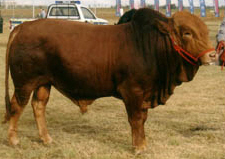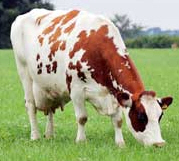



Africander
History
Africander cattle (also known as Afrikaner), were developed from the native Khoi-Khoi cattle of the Cape of Good Hope which are thought to have arisen from the longhorned Zebu and the Egyptian longhorn and is a native South African breed. The Africander belongs to the Sanga type.
Sanga type cattle, in huge herds, were owned by the Hottentots when the Dutch established the Cape Colony in 1652. The animals were obtained by the colonists who improved them for use as draft animals. It was Africander oxen that drew the wagons which carried Boer farmers and families on the Great Trek of 1835-36 from the Cape of Good Hope to the Orange Free State, Natal and the Transvaal to escape British rule. the word trek is originally Afrikaans, meaning draft.

Photo courtesy of Afrikaner Cattle Breeders' Society of South Africa, studbook.co.za |
The breed was almost exterminated when huge numbers died of rinderpest (viral disease of cattle) or were destroyed during the South African War.
Since then the breed has been developed into a competitive beef breed and was the first indigenous South African breed to form a breed society in 1912. Nowadays it is probably the most popular indigenous cattle breed in South Africa. Though the population size in 1998 is reported to be 20,465, its cryogenic conservation in semen form and keeping the animals in the different improvement stations in South Africa is expected to ensure that it is not at risk.
Characteristics
The breed has been bred according to breed standards for many generations and shows a high degree of uniformity in colour and conformation, rarely encountered in other African livestock breeds, it is among the largest breeds in Africa.
The breed is typically red which can vary from light tan to deep cherry red . They have long lateral horns of a flesh to creamy white in colour with amber tips. A polled type has also been developed.
Africander cattle exhibit good resistance to heat, a high level of tick resistance, quiet temperament and a satisfactorily high level of fertility under harsh conditions. It is a heavy beef-type animal and has good meat quality but show lactational anoestrus in times of environmental stress. Mature cows are of a medium size weighing approximately 525 to 600 kg (1150 - 1350 pounds) and bulls weigh 750 to 1000 kg (1650 - 2200 pounds). They have loose skin and large drooping ears. The bulls have the the hump of muscle and fat on the neck which can rise to 7cm or more above the topline similar to the Zebu.
There is considerable variation in the performance of pure Africander cattle, especially in weaning weight and growth rate to slaughter age; but in general they tend to be slow maturing with comparatively low fat cover. The dressing percentage is 54%.
It is not considered to be a milk animal in a country where European dairy breeds supply most of the milk.
Statistics
Cows
- Excellent mothering ability, easy calving and low calf mortality rates
- Weans heavy cross-breed calves
- Capable of producing 10 and more calves in a lifetime
Bulls
- Are virile, active and prolaps free
- Has a long productive life (Up to 12 years and older)
- Produces outstanding mother-line progeny in any cross-breeding program
- Produces top class slaughter oxen on the hoof as well as on the hook with any breed of cow
This hardy, no-nonsense breed has a number of outstanding traits, its value in cross-breeding programmes being particularly appreciated.
The Afrikaner is well named the no-nonsense breed. Livestock specialists say the Afrikaners doesn't have the compact, block-like conformation of many other beef breeds. It has longer legs, yet good depth, and a muscular back, loins, rump and thigh, but a fairly shallow body.
As a purely beef-producing breed, the Afrikaner cow yield excellent and adequate milk for its calves. Experiments have shown that, during a suckling period of 210 days, the calf on average consumes 900 liters of milk. The cow has excellent mothering abilities. It's common on many farms to see a lone cow surrounded by several calves, which are guarded by her, while their own mothers are grazing or on their way to distant watering points. Given good grazing and ample fresh water, the cows calves regularly once a year. Due to the cow's slightly drooping rump and wide vaginal passage, there are few if any calving problems. Calves at birth weigh only about 34 kg, which also ensures easy an uncomplicated calving. The breed thrives under extreme heat.
The age at first calving is about 36 months and calving interval about 445 days; calving percentages are variable and have been compared unfavourably with other indigenous breeds (e.g. Tswana, Tuli, Angoni, Mashona); however, the cows have been used extensively for commercial crossbreeding, with bulls of European breeds, especially Hereford, Sussex, Devon, Simmental and Charolais (Maule 1990).
Distribution
The breed is currently found in Africa, Australia and tropical countries.
References (the above information was cited from the following sites)
Headline image courtesy of NSW Government.


